
Samuel Taliaferro Rayburn was an American politician who served as the 43rd speaker of the United States House of Representatives. He was a three-time House speaker, former House majority leader, two-time House minority leader, and a 24-term congressman, representing Texas's 4th congressional district as a Democrat from 1913 to 1961. He holds the record for the longest tenure as Speaker of the United States House of Representatives, serving for over 17 years.

The Texas State Capitol is the capitol and seat of government of the American state of Texas. Located in downtown Austin, Texas, the structure houses the offices and chambers of the Texas Legislature and of the Governor of Texas. Designed in 1881 by architect Elijah E. Myers, it was constructed from 1882 to 1888 under the direction of civil engineer Reuben Lindsay Walker. A $75 million underground extension was completed in 1993. The building was added to the National Register of Historic Places in 1970 and recognized as a National Historic Landmark in 1986.
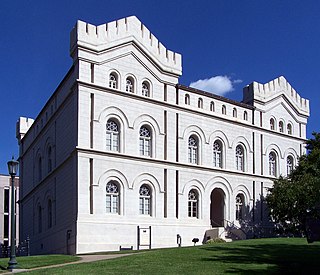
The General Land Office Building, completed in 1857, in Austin, Texas is the oldest surviving state government office building in the city and the first building designed by a university-trained architect. The building features a dramatic medieval castle style known as Rundbogenstil, or "rounded arch" around the windows and doors. There is also a Norman style influence in the castle-like parapets. The exterior walls are limestone rubble smoothed over with stucco and scored to simulate cut stone blocks.

The Old West Austin Historic District is a residential community in Austin, Texas, United States. It is composed of three neighborhoods located on a plateau just west of downtown Austin: Old Enfield, Pemberton Heights, and Bryker Woods. Developed between 1886 and 1953, the three historic neighborhoods stretch from Mopac Expressway east to Lamar Boulevard, and from 13th Street north to 35th Street. It borders Clarksville Historic District and the West Line Historic District to the south.

The Lundberg Bakery is a historic building in downtown Austin, Texas. It is located at 1006 Congress Avenue, half a block south of the Texas State Capitol grounds. It was added to the National Register of Historic Places on December 17, 1969.
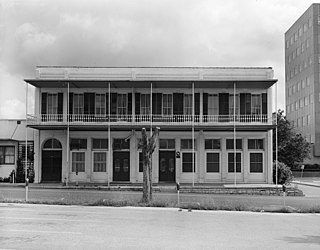
The Goodman Building is a late Victorian style historic commerce building in downtown Austin, Texas. It was constructed as a grocery in the mid-1880s to serve Austinites northwest of the Texas State Capitol. Today it serves as a state government adjunct office. A local bar, "The Cloak Room," occupies the basement and is a favorite for government employees. It is located at 202 W. 13th Street. The building was added to the National Register of Historic Places in 1973.
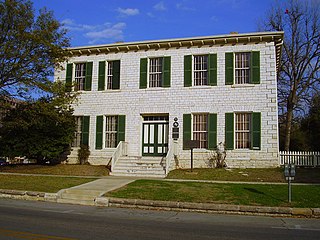
The Carrington–Covert House is a historic building in downtown Austin, Texas that serves as headquarters of the Texas Historical Commission. Built between 1855 and 1857, it is one of the few surviving pre-Civil War structures in the city.
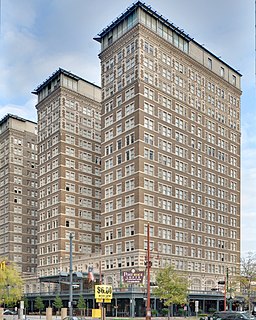
The Rice, formerly the Rice Hotel, is an historic building at 909 Texas Avenue in Downtown Houston, Texas, United States. The current building is the third to occupy the site. It was completed in 1913 on the site of the former Capitol building of the Republic of Texas, and is listed on the National Register of Historic Places. The old Capitol building was operated as a hotel until it was torn down and replaced by a new hotel around 1881. Jesse H. Jones built a new seventeen-story, double-winged hotel in 1913, also called "The Rice Hotel." This building underwent major expansions: adding a third wing in 1925, adding an eighteenth floor in 1951, and adding a five-story "motor lobby in 1958. In addition, there were several renovations during its life as a hotel. It continued to operate as a hotel before finally shutting down in 1977. After standing vacant for twenty-one years, The Rice was renovated as apartments and reopened in 1998 as the Post Rice Lofts. It was sold in 2014 and renamed simply The Rice.
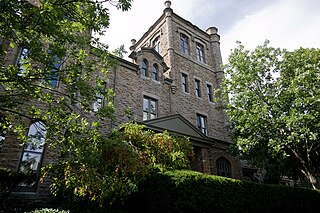
Sacred Heart Academy is a historic former residence and school in the city of Cincinnati, Ohio, United States. Built as the home of a wealthy man, it was the location of a Catholic school for most of its history. As a work of a regionally prominent architect, it has been named a historic site.

The Southgate–Lewis House is located one mile east of the Texas State Capital in Austin, Texas, at 1501 East 12th Street. The house was constructed in 1888, and now stands as an African-American historical landmark. It is also a repository for African-American History and Culture in the region of east Austin, which historically became an African-American neighborhood. The City of Austin has now declared this region to be "Austin's Black Cultural District." The Southgate–Lewis House is located in the center of the "African American Cultural Heritage District".

The Sam Rayburn House Museum is a historic house museum at 890 West Texas State Highway 56 in Bonham, Fannin, Texas. Built in 1916, it was home to Sam Rayburn (1882-1961), a famously effective Speaker of the United States House of Representatives. It was declared a National Historic Landmark in 1976. Since 1972, it has been operated as a museum and state historic site by the Texas Historical Commission.

Gethsemane Lutheran Church is a historic Lutheran church in downtown Austin, Texas. Designated as a Recorded Texas Historic Landmark and listed on the National Register of Historic Places, the building currently holds offices of the Texas Historical Commission.

The architectural structures of Fredericksburg, Texas are often unique to the Texas Hill Country, and are historical edifices of the German immigrants who settled the area in the 19th Century. Many of the structures have historic designations on a state or national level. The Gillespie County Historical Society is actively involved in assisting with preservation.
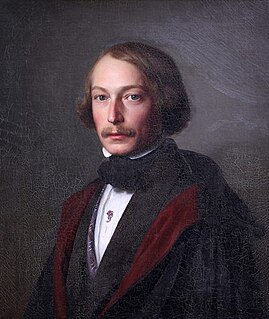
Hermann Lungkwitz (1813–1891) was a 19th-century German-born Texas romantic landscape artist and photographer whose work became the first pictoral record of the Texas Hill Country.
Jacob Bickler was a scholar, educator and president of the Texas State Teacher's Association. He was founder of the boys' Texas German and English Academy and the co-educational Bickler Academy, both located in Austin, Texas. In 1969, Recorded Historic Texas Landmark 6438 was placed at the site of the Goodman Building, noting the location on the second floor of Jacob Bickler's German and English academy.
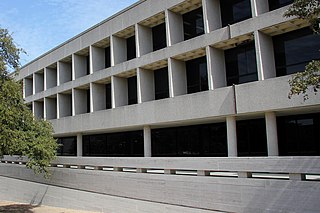
The Dolph Briscoe Center for American History is an organized research unit and public service component of The University of Texas at Austin named for Dolph Briscoe, the 41st Governor of Texas. The Center collects and preserves documents and artifacts of key themes in Texas and United States history and makes the items available to researchers. The center also has permanent, touring, and online exhibits available to the public. The center's divisions include Research and Collections, the Sam Rayburn Museum, the Briscoe-Garner Museum, and Winedale.

The Judge Sebron G. Sneed House is a historic former limestone plantation house in Austin, Texas, commissioned by Judge Sebron Graham Sneed. It was likely designed by architect and general contractor, Abner Hugh Cook, co-owner of the sawmill where Sneed had purchased lumber for the construction of the house. Cook is most notable for designing the Texas Governor's Mansion in Austin.

The Westgate Tower is a mixed-use high-rise building in downtown Austin, Texas. The twenty-six-story 261-foot (80 m) tower block was designed in 1962 and completed in 1966; its name reflects its location across the street from the west gate of the Texas State Capitol. Designed by architect Edward Durell Stone, the tower was added to the National Register of Historic Places in 2010 and designated a Recorded Texas Historic Landmark in 2012.

The Capitol View Corridors are a series of legal restrictions on construction in Austin, Texas, aimed at preserving protected views of the Texas State Capitol from various points around the city. First established by the Texas Legislature in 1983 and recodified in 2001, the corridors are meant to protect the capitol dome from obstruction by high-rise buildings. While supported by cultural and historical preservation organizations, the corridors have also been criticized for limiting the potential for the development of new tall structures in downtown Austin.

The Heman Marion Sweatt Travis County Courthouse is the county courthouse for Travis County, Texas. Located in downtown Austin, Texas, the courthouse holds civil and criminal trial courts and other functions of county government. The courthouse was built between 1930 and 1931 in the then-contemporary PWA Moderne style, and it was later expanded in 1958 and 1962.





















